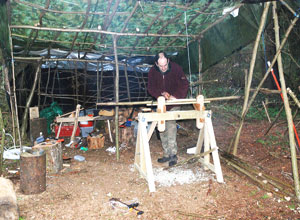That is a question I had as I noticed the dome willow structures for sale are the living kind where all the leaves grow around the surface. I did wonder what would happen if that were covered over with a tarp or what not.The thing about a bender is that it can be incredibly temporary.
At this time of year my willows are four metres tall, and I can just bend them down, tie a bit of string onto the tip and fasten that down with a big peg.
They arch beautifully, let me throw a chute over the top and give me shelter enough out of the wind and the smirr.
You don't need to kill trees to make a bender if you have willow and hazel is kind of what I'm getting at.
Especially when they are out of leaf.
Just uncover them and they'll grow again. Indeed, if you just leave them they'll happily spread their roots and come up with fresh shoots in the light beside the walls.
A great stealthy structure would be somehow having the skin inside and allowing the trees to still grow unfettered on the outside. Not sure how you would attach that though without loads of hole to keep the inner skin up unless you did a double dome and put the skin over the inner one.









